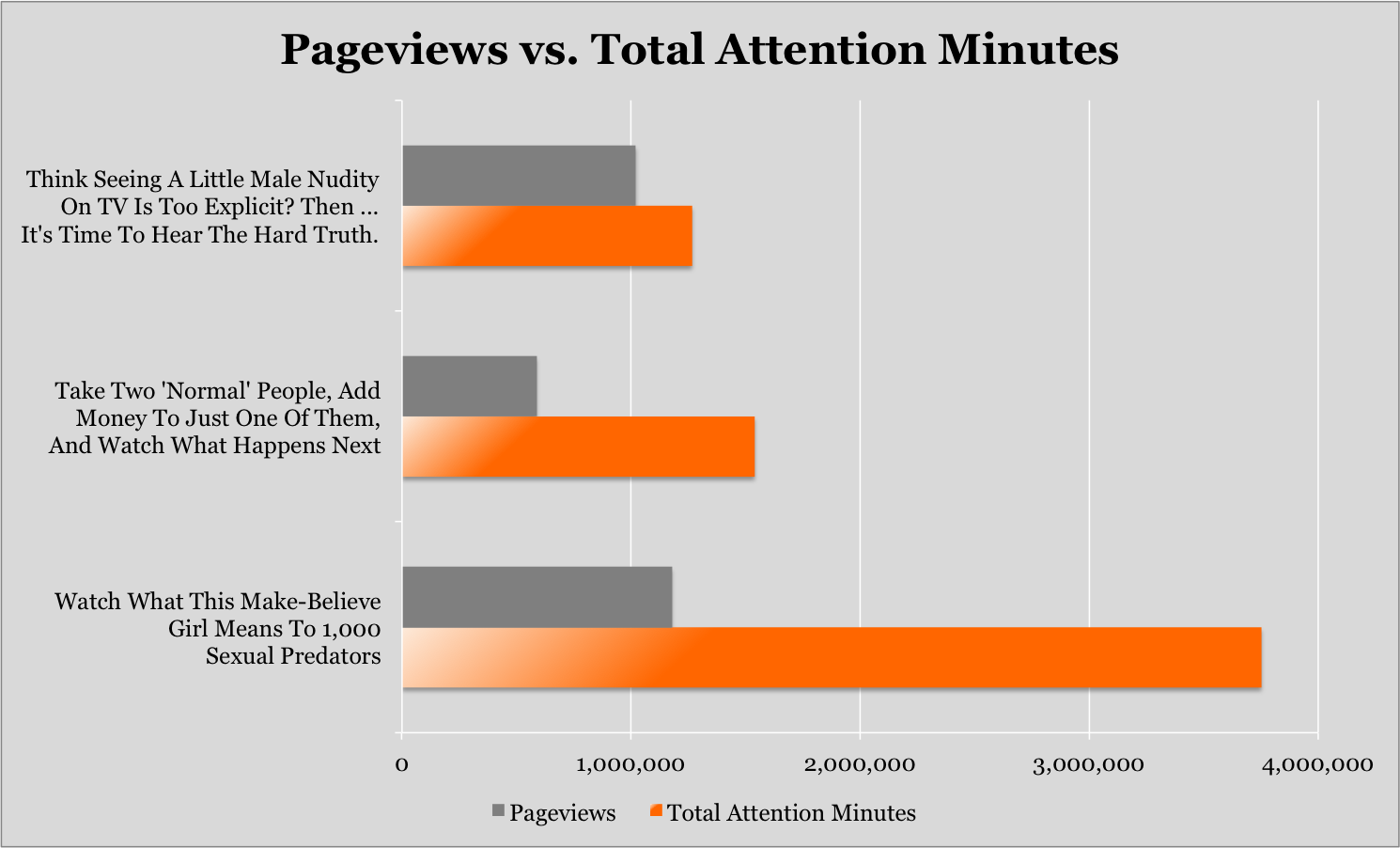
Total attention minutes report different results than page views. Courtesy of Upworthy
Attention-based metrics are touted by some as the new measurement standard that’s far superior to traditional metrics like page views or impressions. Attention-based metrics essentially measure how long website visitors view content.
Some of the media companies adopting attention metrics include The Financial Times, The Economist Group and Upworthy. Publishers vary in their terminology and how they implement the metrics. Upworthy implemented two forms of “attention minutes.”
Total attention on site per day, week or month measures Upworthy’s overall popularity. Total attention per piece measures how many people see an HTML page and how long they view it. Its measurement is more precise than the more common time on page metric.
Marketing experts say attention metrics could improve digital advertising and marketing. They can help publishers identify their best content and counter click-bait articles. When page views are the deciding metric, content producers may be tempted to lure viewers to open articles with enticing — and sometimes misleading – headlines.
The Next Evolution
Chris Stark, senior vice president of product marketing at Grapeshot, urges marketers to embrace attention metrics. “It’s the next evolution of marketing metrics,” Stark told Direct Marketing News. “The important thing that we can’t lose sight of is making sure we create metrics that translate into something meaningful and material. That’s why the attention metric is so exciting; we’re figuring out dimension in addition to duration. It’s a new level of capability.”
The digital marketing community should not underestimate the metric’s importance, says Jonah Goodhart, CEO and co-founder of Moat analytics.
“The trend for marketers and publishers to begin transacting on attention metrics is a key shift in the industry and signals the importance of changing how we evaluate advertising success in digital,” he told Digiday.
“It’s an interesting trend. Generally, I’m very supportive of any publisher that is improving the quality of their layout,” Damien Healy, at WPP Group’s ad buying network Xaxis, told Digiday. The biggest disadvantage is its potential to further complicate marketing and advertising.
Improved Marketing Campaigns
The longer viewers pay attention to the content, the more likely they are to seek more content or information, according to the new ChartBeat report, The Four Data Science Studies Brands Are Putting Their Money Behind. That means marketers can develop and improve campaigns based on attention-based metrics. Audiences who spend more time with the brand’s messages are more likely to recall the product. Marketers can target these customers.
Chasing impressions without regard for the time actively spent with the message could actually work to reinforce less favorable or irrelevant brand attributes. Viewers with unfavorable brand impressions will spend only enough time to validate their preconceived notions and/or reject the value proposition.
Attention-Metric Examples
ChartBeat cites some attention-metric examples. A major consumer package goods company sought to grow a new, younger audience. Seeking to encourage repeat site visitors and to increase overall brand loyalty, the company aimed for everyday relevance instead of one-off seasonable spikes. It found that its newest audience engaged most with simple comfort recipes with organic ingredients and ways to buy them locally. This insight prompted brand to rename recipes and share their local-organic origins specifically through the channels that brought in this audience.
A luxury automobile brand wanted affluent urban buyers to recall specific green-initiatives in its new car. It developed a display campaign targeting high-net worth drivers in four major cities and based its advertising campaign on viewable impressions seen for an extended period of time, 9 to 14 seconds, instead of the standard one-second viewable impression. That strategy increased the brand’s recall with the target audience for an extended period of time after the initial ad views.
Bottom Line: Some experts say attention-based metrics are the future of online marketing measurement. Instead of counting clicks of page views, attention metrics focus on how long web visitors view content. The metrics offers marketers a more accurate way to identify their most engaging content and best audiences.
William J. Comcowich founded and served as CEO of CyberAlert LLC, the predecessor of Glean.info. He is currently serving as Interim CEO and member of the Board of Directors. Glean.info provides customized media monitoring, media measurement and analytics solutions across all types of traditional and social media.




